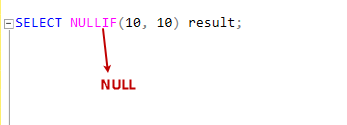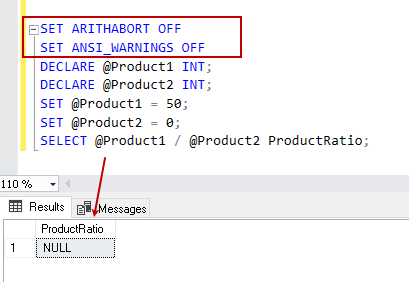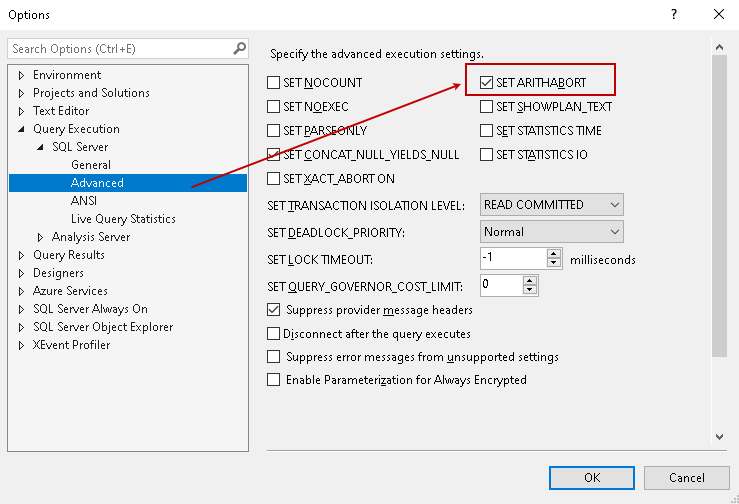EDIT:
I’m getting a lot of downvotes on this recently…so I thought I’d just add a note that this answer was written before the question underwent it’s most recent edit, where returning null was highlighted as an option…which seems very acceptable. Some of my answer was addressed to concerns like that of Edwardo, in the comments, who seemed to be advocating returning a 0. This is the case I was railing against.
ANSWER:
I think there’s an underlying issue here, which is that division by 0 is not legal. It’s an indication that something is fundementally wrong. If you’re dividing by zero, you’re trying to do something that doesn’t make sense mathematically, so no numeric answer you can get will be valid. (Use of null in this case is reasonable, as it is not a value that will be used in later mathematical calculations).
So Edwardo asks in the comments «what if the user puts in a 0?», and he advocates that it should be okay to get a 0 in return. If the user puts zero in the amount, and you want 0 returned when they do that, then you should put in code at the business rules level to catch that value and return 0…not have some special case where division by 0 = 0.
That’s a subtle difference, but it’s important…because the next time someone calls your function and expects it to do the right thing, and it does something funky that isn’t mathematically correct, but just handles the particular edge case it’s got a good chance of biting someone later. You’re not really dividing by 0…you’re just returning an bad answer to a bad question.
Imagine I’m coding something, and I screw it up. I should be reading in a radiation measurement scaling value, but in a strange edge case I didn’t anticipate, I read in 0. I then drop my value into your function…you return me a 0! Hurray, no radiation! Except it’s really there and it’s just that I was passing in a bad value…but I have no idea. I want division to throw the error because it’s the flag that something is wrong.
This article explores the SQL divide by zero error and various methods for eliminating this.
Introduction
We all know that in math, it is not possible to divide a number by zero. It leads to infinity:

Source: www.1dividedby0.com
If you try to do in calculator also, you get the error message – Cannot Divide by zero:
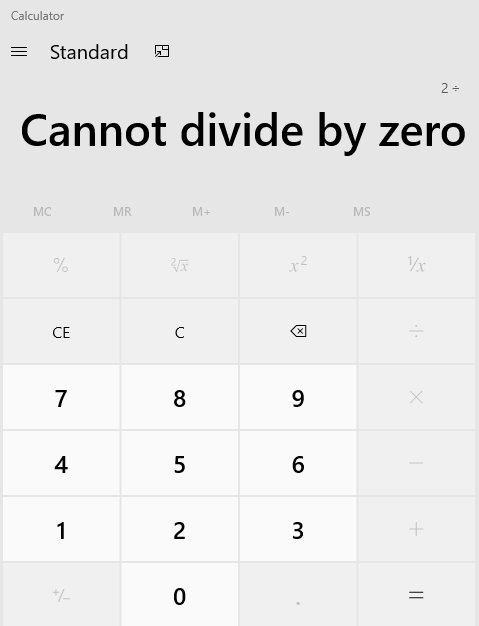
We perform data calculations in SQL Server for various considerations. Suppose we perform an arithmetic division operator for calculating a ratio of products in a store. Usually, the division works fine, and we get the ratio:
|
DECLARE @Product1 INT; DECLARE @Product2 INT; SET @Product1 = 50; SET @Product2 = 10; SELECT @Product1 / @Product2 ProductRatio; |

Someday, the product2 quantity goes out of stock and that means we do not have any quantity for product2. Let’s see how the SQL Server query behaves in this case:
|
DECLARE @Product1 INT; DECLARE @Product2 INT; SET @Product1 = 50; SET @Product2 = 0; SELECT @Product1 / @Product2 ProductRatio; |
We get SQL divide by zero error messages (message id 8134, level 16):
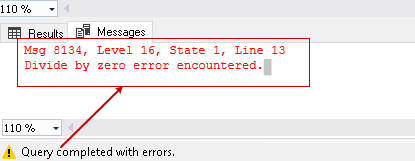
We do not want our code to fail due to these errors. It is a best practice to write code in such a way that it does not give divide by zero message. It should have a mechanism to deal proactively with such conditions.
SQL Server provides multiple methods for avoiding this error message. Let’s explore it in the next section.
Method 1: SQL NULLIF Function
We use NULLIF function to avoid divide by zero error message.
The syntax of NULLIF function:
|
NULLIF(expression1, expression2) |
It accepts two arguments.
-
If both the arguments are equal, it returns a null value
For example, let’s say both arguments value is 10:
SELECT NULLIF(10, 10) result;
In the screenshot, we can see that the output is null:
-
If both the arguments are not equal, it returns the value of the first argument
In this example, both argument values differ. It returns the output as value of first argument 10:
SELECT NULLIF(10, 5) result;
Let’s modify our initial query using the SQL NULLIF statement. We place the following logic using NULLIF function for eliminating SQL divide by zero error:
- Use NULLIF function in the denominator with second argument value zero
- If the value of the first argument is also, zero, this function returns a null value. In SQL Server, if we divide a number with null, the output is null as well
- If the value of the first argument is not zero, it returns the first argument value and division takes place as standard values
|
DECLARE @Product1 INT; DECLARE @Product2 INT; SET @Product1 = 50; SET @Product2 = 0; SELECT @Product1 / NULLIF(@Product2,0) ProductRatio; |
Execute this modified query. We can see the output NULL because denominator contains value zero.
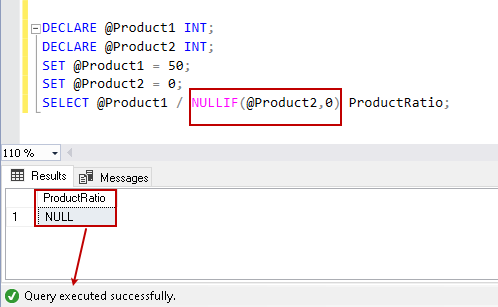
Do we want null value in the output? Is there any method to avoid null and display a definite value?
Yes, we can use SQL ISNULL function to avoid null values in the output. This function replaces the null value in the expression1 and returns expression2 value as output.
Let’s explore the following query with a combination of SQL NULLIF and SQL ISNULL function:
- First argument ((@Product1 / NULLIF(@Product2,0)) returns null
- We use the ISNULL function and specify the second argument value zero. As we have the first argument null, the output of overall query is zero (second argument value)
|
DECLARE @Product1 INT; DECLARE @Product2 INT; SET @Product1 = 50; SET @Product2 = 0; SELECT ISNULL(@Product1 / NULLIF(@Product2,0),0) ProductRatio; |
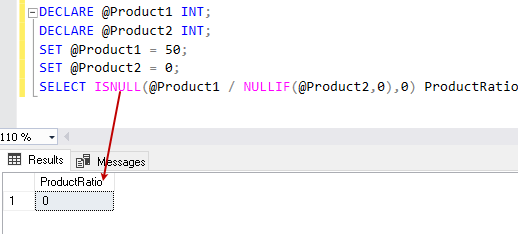
Method 2: Using CASE statement to avoid divide by zero error
We can use a CASE statement in SQL to return values based on specific conditions. Look at the following query. It does the following task with the Case statement.
The Case statement checks for the value of @Product2 parameter:
- If the @Product2 value is zero, it returns null
- If the above condition is not satisfied, it does the arithmetic operation (@Product1/@Product2) and returns the output
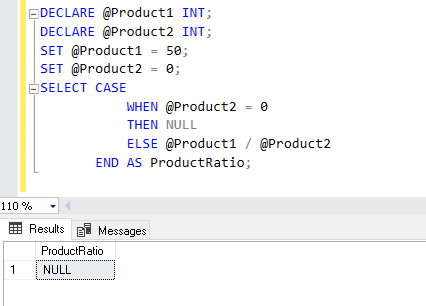
Method 3: SET ARITHABORT OFF
We can use set methods to control query behavior. By default, SQL Server has a default value of SET ARITHABORT is ON. We get SQL divide by zero error in the output using the default behavior.
The T-SQL syntax for controlling the ARITHABORT option is shown below:
|
SET ARITHABORT { ON | OFF } |
-
Using ARITHABORT ON, the query will terminate with divide by zero message. It is the default behavior. For this demo, let’s enable it using the SET ARITHABORT ON statement:
SET ARITHABORT ON — Default
SET ANSI_WARNINGS ON
DECLARE @Product1 INT;
DECLARE @Product2 INT;
SET @Product1 = 50;
SET @Product2 = 0;
SELECT @Product1 / @Product2 ProductRatio;
We get the SQL divide by zero error messages:
-
Using ARITHABORT OFF, the batch will terminate and returns a null value. We need to use ARITHABORT in combination with SET ANSI_WARNINGS OFF to avoid the error message:
We can use the following query to check the current setting for the ARITHABORT parameter:
DECLARE @ARITHABORT VARCHAR(3) = ‘OFF’;
IF ( (64 & @@OPTIONS) = 64 ) SET @ARITHABORT = ‘ON’;
SELECT @ARITHABORT AS ARITHABORT;
The default ARITHABORT setting for SSMS is ON. We can view it using SSMS Tools properties. Navigate to Tools -> Options -> Advanced:
Many client applications or drivers provide a default value of ARITHABORT is OFF. The different values might force SQL Server to produces a different execution plan, and it might create performance issues. You should also match the setting similar to a client application while troubleshooting the performance issues.
Note: You should not modify the value of ARITHABORT unless required. It might create performance issues, as well. I would suggest using alternative methods (as described earlier) for avoiding SQL divide by zero error.
Conclusion
In this article, we explored the various methods for avoiding SQL divide by zero error. It is best practice to be proactive and use these mechanisms so that code does not fail in real-time.
- Author
- Recent Posts
Hi! I am Rajendra Gupta, Database Specialist and Architect, helping organizations implement Microsoft SQL Server, Azure, Couchbase, AWS solutions fast and efficiently, fix related issues, and Performance Tuning with over 14 years of experience.
I am the author of the book «DP-300 Administering Relational Database on Microsoft Azure». I published more than 650 technical articles on MSSQLTips, SQLShack, Quest, CodingSight, and SeveralNines.
I am the creator of one of the biggest free online collections of articles on a single topic, with his 50-part series on SQL Server Always On Availability Groups.
Based on my contribution to the SQL Server community, I have been recognized as the prestigious Best Author of the Year continuously in 2019, 2020, and 2021 (2nd Rank) at SQLShack and the MSSQLTIPS champions award in 2020.
Personal Blog: https://www.dbblogger.com
I am always interested in new challenges so if you need consulting help, reach me at rajendra.gupta16@gmail.com
View all posts by Rajendra Gupta
Время прочтения: 4 мин.
В процессе работы c данными в SQL Server, мы столкнулись с такой ситуацией. Одним из промежуточных шагов в нашей задаче было выполнение простого арифметического действия, из данных в виде целых чисел, загружаемых в таблицу SQL, значения которых участвовали в делении. В какой-то момент времени выполнение всего кода могло быть прервано сообщением об ошибке из-за того, что знаменатель принимал значение 0. Как этого избежать подобной ситуации, я расскажу в этой статье.
Обычно при делении не возникает проблем, и мы получаем соотношение двух величин, если знаменатель не равен нулю:
declare @vol_1 int;
declare @vol_2 int;
set @vol_1 = 10;
set @vol_2 = 5;
select @vol_1/@vol_2 ratio_vol;
Соотношение значений вычисляется корректно:
При значении @vol_2 = 0 получаем сообщение об ошибке:
declare @vol_1 int;
declare @vol_2 int;
set @vol_1 = 10;
set @vol_2 = 0;
select @vol_1/@vol_2 ratio_vol;
Для того, чтобы ошибка не возникала при выполнении запроса предлагается предусмотреть механизм, позволяющий справляться с условием, когда значение @vol_2 станет равным нулю
1. Применение функции NULLIF.
Синтаксис NULLIF следующий:
NULLIF(expr1, expr2)При равенстве значений двух аргументов, возвращается значение NULL.
Например:
select NULLIF (55, 55) result;Результат запроса:
Если значения аргументов не равны, возвращается значение первого аргумента (expr1).
select NULLIF (12, 55) result;Изменим этот запрос, добавив в него NULLIF, для обхода ошибки деления на ноль.
Логика использования функции NULLIF для задачи деления на ноль следующая:
- используем в знаменателе функцию NULLIF с нулевым значением ее второго аргумента
- если значение первого аргумента функции NULLIF также равно нулю, то возвращается значение NULL, и тогда в SQL Server, если мы разделим число на значение NULL, на выходе получим NULL.
- если значение первого аргумента не равно нулю, возвращается значение первого аргумента функции NULLIF, и деление выполняется как стандартная операция деления.
declare @vol_1 int;
declare @vol_2 int;
set @vol_1 = 10;
set @vol_2 = 0;
select @vol_1/NULLIF (@vol_2, 0) ratio_vol;
Ниже, результат работы такого кода (в знаменателе – значение NULL):
Добавим в код функцию ISNULL, для того, чтобы вместо значения NULL в выводе результата вычисления получать 0.
Эта функция заменяет NULL значение в expr1 и возвращает значение expr2 в качестве вывода.
Логика запроса с функциями ISNULL и NULLIF такая:
- первый аргумент ((@vol_1/ NULLIF (@vol_2,0)) вернет значение NULL;
- для функции ISNULL указываем нулевое значение второго аргумента;
- так как первый аргумент — NULL, то вывод всего запроса равен нулю, т.е. значению второго аргумента.
Пример кода с функциями ISNULL и NULLIF:
declare @vol_1 int;
declare @vol_2 int;
set @vol_1 = 10;
set @vol_2 = 0;
select ISNULL (@vol_1/NULLIF (@vol_2, 0),0) ratio_vol;
Вывод результата успешного выполнения запроса:
2. Использование оператора CASE.
Посмотрим, как использовать для нашей задачи оператор CASE для возврата значений на основе определенных условий.
Оператор CASE проверит значение параметра @vol_2:
- если значение @vol_2 равно нулю, возвращается значение NULL;
- если это условие не выполняется, то производится арифметическая операция деления (@vol_1/@vol_2) и возвращается ее результат.
declare @vol_1 int;
declare @vol_2 int;
set @vol_1 = 10;
set @vol_2 = 0;
select CASE
when @vol_2 = 0
then NULL
else @vol_1/@vol_2
end as ratio_vol;
Успешный результат запроса:
Применяя рассмотренные методы, позволяющие избежать ошибки деления на ноль в SQL Server, можно быть уверенным в том, что этот специфический, с точки зрения арифметики, код, являющийся частью большей задачи, не даст сбой в результате ее решения.
EDIT:
I’m getting a lot of downvotes on this recently…so I thought I’d just add a note that this answer was written before the question underwent it’s most recent edit, where returning null was highlighted as an option…which seems very acceptable. Some of my answer was addressed to concerns like that of Edwardo, in the comments, who seemed to be advocating returning a 0. This is the case I was railing against.
ANSWER:
I think there’s an underlying issue here, which is that division by 0 is not legal. It’s an indication that something is fundementally wrong. If you’re dividing by zero, you’re trying to do something that doesn’t make sense mathematically, so no numeric answer you can get will be valid. (Use of null in this case is reasonable, as it is not a value that will be used in later mathematical calculations).
So Edwardo asks in the comments «what if the user puts in a 0?», and he advocates that it should be okay to get a 0 in return. If the user puts zero in the amount, and you want 0 returned when they do that, then you should put in code at the business rules level to catch that value and return 0…not have some special case where division by 0 = 0.
That’s a subtle difference, but it’s important…because the next time someone calls your function and expects it to do the right thing, and it does something funky that isn’t mathematically correct, but just handles the particular edge case it’s got a good chance of biting someone later. You’re not really dividing by 0…you’re just returning an bad answer to a bad question.
Imagine I’m coding something, and I screw it up. I should be reading in a radiation measurement scaling value, but in a strange edge case I didn’t anticipate, I read in 0. I then drop my value into your function…you return me a 0! Hurray, no radiation! Except it’s really there and it’s just that I was passing in a bad value…but I have no idea. I want division to throw the error because it’s the flag that something is wrong.
EDIT:
I’m getting a lot of downvotes on this recently…so I thought I’d just add a note that this answer was written before the question underwent it’s most recent edit, where returning null was highlighted as an option…which seems very acceptable. Some of my answer was addressed to concerns like that of Edwardo, in the comments, who seemed to be advocating returning a 0. This is the case I was railing against.
ANSWER:
I think there’s an underlying issue here, which is that division by 0 is not legal. It’s an indication that something is fundementally wrong. If you’re dividing by zero, you’re trying to do something that doesn’t make sense mathematically, so no numeric answer you can get will be valid. (Use of null in this case is reasonable, as it is not a value that will be used in later mathematical calculations).
So Edwardo asks in the comments «what if the user puts in a 0?», and he advocates that it should be okay to get a 0 in return. If the user puts zero in the amount, and you want 0 returned when they do that, then you should put in code at the business rules level to catch that value and return 0…not have some special case where division by 0 = 0.
That’s a subtle difference, but it’s important…because the next time someone calls your function and expects it to do the right thing, and it does something funky that isn’t mathematically correct, but just handles the particular edge case it’s got a good chance of biting someone later. You’re not really dividing by 0…you’re just returning an bad answer to a bad question.
Imagine I’m coding something, and I screw it up. I should be reading in a radiation measurement scaling value, but in a strange edge case I didn’t anticipate, I read in 0. I then drop my value into your function…you return me a 0! Hurray, no radiation! Except it’s really there and it’s just that I was passing in a bad value…but I have no idea. I want division to throw the error because it’s the flag that something is wrong.
SQL Server 2017 Developer on Windows SQL Server 2017 Enterprise on Windows SQL Server 2017 Enterprise Core on Windows SQL Server 2017 Standard on Windows Еще…Меньше
Проблемы
Предположим, что у вас есть большое количество параллельных запросов, которые работают в работающей системе SQL Server 2017. При выполнении параллельного запроса вы можете заметить, что параллельный запрос принудительно запускается в последовательном режиме из-за нехватки параллельных рабочих потоков. В этом случае ошибка «выделять память – предупреждение» может вызвать ошибку деления на ноль.
Решение
Эта проблема устранена в следующем накопительном обновлении SQL Server:
Накопительное обновление 1 для SQL Server 2017
Все новые накопительные обновления для SQL Server содержат все исправления и все исправления для системы безопасности, которые были включены в предыдущий накопительный пакет обновления. Ознакомьтесь с самыми последними накопительными обновлениями для SQL Server.
Последнее накопительное обновление для SQL Server 2017
Статус
Корпорация Майкрософт подтверждает наличие этой проблемы в своих продуктах, которые перечислены в разделе «Применяется к».
Ссылки
Ознакомьтесь с терминологией, которую корпорация Майкрософт использует для описания обновлений программного обеспечения.
Нужна дополнительная помощь?
EDIT:
I’m getting a lot of downvotes on this recently…so I thought I’d just add a note that this answer was written before the question underwent it’s most recent edit, where returning null was highlighted as an option…which seems very acceptable. Some of my answer was addressed to concerns like that of Edwardo, in the comments, who seemed to be advocating returning a 0. This is the case I was railing against.
ANSWER:
I think there’s an underlying issue here, which is that division by 0 is not legal. It’s an indication that something is fundementally wrong. If you’re dividing by zero, you’re trying to do something that doesn’t make sense mathematically, so no numeric answer you can get will be valid. (Use of null in this case is reasonable, as it is not a value that will be used in later mathematical calculations).
So Edwardo asks in the comments «what if the user puts in a 0?», and he advocates that it should be okay to get a 0 in return. If the user puts zero in the amount, and you want 0 returned when they do that, then you should put in code at the business rules level to catch that value and return 0…not have some special case where division by 0 = 0.
That’s a subtle difference, but it’s important…because the next time someone calls your function and expects it to do the right thing, and it does something funky that isn’t mathematically correct, but just handles the particular edge case it’s got a good chance of biting someone later. You’re not really dividing by 0…you’re just returning an bad answer to a bad question.
Imagine I’m coding something, and I screw it up. I should be reading in a radiation measurement scaling value, but in a strange edge case I didn’t anticipate, I read in 0. I then drop my value into your function…you return me a 0! Hurray, no radiation! Except it’s really there and it’s just that I was passing in a bad value…but I have no idea. I want division to throw the error because it’s the flag that something is wrong.
EDIT:
I’m getting a lot of downvotes on this recently…so I thought I’d just add a note that this answer was written before the question underwent it’s most recent edit, where returning null was highlighted as an option…which seems very acceptable. Some of my answer was addressed to concerns like that of Edwardo, in the comments, who seemed to be advocating returning a 0. This is the case I was railing against.
ANSWER:
I think there’s an underlying issue here, which is that division by 0 is not legal. It’s an indication that something is fundementally wrong. If you’re dividing by zero, you’re trying to do something that doesn’t make sense mathematically, so no numeric answer you can get will be valid. (Use of null in this case is reasonable, as it is not a value that will be used in later mathematical calculations).
So Edwardo asks in the comments «what if the user puts in a 0?», and he advocates that it should be okay to get a 0 in return. If the user puts zero in the amount, and you want 0 returned when they do that, then you should put in code at the business rules level to catch that value and return 0…not have some special case where division by 0 = 0.
That’s a subtle difference, but it’s important…because the next time someone calls your function and expects it to do the right thing, and it does something funky that isn’t mathematically correct, but just handles the particular edge case it’s got a good chance of biting someone later. You’re not really dividing by 0…you’re just returning an bad answer to a bad question.
Imagine I’m coding something, and I screw it up. I should be reading in a radiation measurement scaling value, but in a strange edge case I didn’t anticipate, I read in 0. I then drop my value into your function…you return me a 0! Hurray, no radiation! Except it’s really there and it’s just that I was passing in a bad value…but I have no idea. I want division to throw the error because it’s the flag that something is wrong.
Here are five options for dealing with error Msg 8134 “Divide by zero error encountered” in SQL Server.
First, here’s an example of code that produces the error we’re talking about:
SELECT 1 / 0;Result:
Msg 8134, Level 16, State 1, Line 1 Divide by zero error encountered.
We get the error because we’re trying to divide a number by zero. Mathematically, this does not make any sense. You can’t divide a number by zero and expect a meaningful result.
To deal with this error, we need to decide what should be returned when we try to divide by zero. For example, we might want a null value to be returned. Or we might want zero to be returned. Or some other value.
Below are some options for dealing with this error.
Option 1: The NULLIF() Expression
A quick and easy way to deal with this error is to use the NULLIF() expression:
SELECT 1 / NULLIF( 0, 0 );Result:
NULL
NULLIF() returns NULL if the two specified expressions are the same value. It returns the first expression if the two expressions are different. Therefore, if we use zero as the second expression, we will get a null value whenever the first expression is zero. Dividing a number by NULL results in NULL.
Actually, SQL Server already returns NULL on a divide-by-zero error, but in most cases we don’t see this, due to our ARITHABORT and ANSI_WARNINGS settings (more on this later).
Option 2: Add the ISNULL() Function
In some cases, you might prefer to return a value other than NULL.
In such cases, you can pass the previous example to the ISNULL() function:
SELECT ISNULL(1 / NULLIF( 0, 0 ), 0);Result:
0
Here I specified that zero should be returned whenever the result is NULL.
Be careful though. In some cases, returning zero might be inappropriate. For example, if you’re dealing with inventory supplies, specifying zero might imply that there are zero products, which might not be the case.
Option 3: Use a CASE Statement
Another way to do it is to use a CASE statement:
DECLARE @n1 INT = 20;
DECLARE @n2 INT = 0;
SELECT CASE
WHEN @n2 = 0
THEN NULL
ELSE @n1 / @n2
ENDResult:
NULL
Option 4: The SET ARITHABORT Statement
The SET ARITHABORT statement ends a query when an overflow or divide-by-zero error occurs during query execution. We can use it in conjunction with SET ANSI WARNINGS to return NULL whenever the divide-by-zero error might occur:
SET ARITHABORT OFF;
SET ANSI_WARNINGS OFF;
SELECT 20 / 0;Result:
NULL
Microsoft recommends that you always set ARITHABORT to ON in your logon sessions, and that setting it to OFF can negatively impact query optimisation, leading to performance issues.
Some clients (such as SQL Server Management Studio) set ARITHABORT to ON by default. This is why you probably don’t see the NULL value being returned when you divide by zero. You can use SET ARITHIGNORE to change this behaviour if you prefer.
Option 5: The SET ARITHIGNORE Statement
The SET ARITHIGNORE statement controls whether error messages are returned from overflow or divide-by-zero errors during a query:
SET ARITHABORT OFF;
SET ANSI_WARNINGS OFF;
SET ARITHIGNORE ON;
SELECT 1 / 0 AS Result_1;
SET ARITHIGNORE OFF;
SELECT 1 / 0 AS Result_2;Result:
Commands completed successfully. Commands completed successfully. Commands completed successfully. +------------+ | Result_1 | |------------| | NULL | +------------+ (1 row affected) Commands completed successfully. +------------+ | Result_2 | |------------| | NULL | +------------+ Division by zero occurred.
Here, I set ARITHABORT and ANSI_WARNINGS to OFF so that the statement wasn’t aborted due to the error, and NULL is returned whenever there’s a divide-by-zero error.
Note that the SET ARITHIGNORE setting only controls whether an error message is returned. SQL Server returns a NULL in a calculation involving an overflow or divide-by-zero error, regardless of this setting.
In the above example we can see that when ARITHIGNORE is ON, the division by zero error is not returned. When it’s OFF, the division by zero error message is returned.
sooo_ez
23.06.16 — 17:01
{ОбщийМодуль.ДлительныеОперации.Модуль(167)}: Ошибка при выполнении операции над данными:
Microsoft SQL Server Native Client 11.0: Обнаружена ошибка: деление на ноль.
HRESULT=80040E14, SQLSrvr: SQLSTATE=22012, state=1, Severity=10, native=8134, line=1
ВызватьИсключение(ТекстОшибки);
Запрос норм работает
В «Настройки — Отчет — Отбор» есть флаг, когда тыкаю на форме «Ложь» ошибка есть, когда «Истина» ошибки нет.
Как можно посмотреть конечный запрос СКД? или, если кто встречался с такой ситуацией, можно ли обойти этот момент?
MrStomak
1 — 23.06.16 — 17:05
Главное — ни в коем случае не пости сюда текст своего запроса, скрывай до последнего!
sooo_ez
2 — 23.06.16 — 17:13
ВЫБРАТЬ
ПланыМероприятийСрезПоследних.Мероприятие КАК Мероприятие,
ПланыМероприятийСрезПоследних.Статус КАК Статус,
ПланыМероприятийСрезПоследних.КБК КАК КБК,
ПланыМероприятийСрезПоследних.Департамент КАК Департамент,
ПланыМероприятийСрезПоследних.Мероприятие.НачалоПроведенияМероприятия КАК НачалоПроведенияМероприятия,
ПланыМероприятийСрезПоследних.Мероприятие.ОкончаниеПроведенияМероприятия КАК ОкончаниеПроведенияМероприятия,
СУММА(ЕСТЬNULL(СуммаМероприятияОбороты.СуммаФБОборот, 0)) КАК СуммаФБ,
СУММА(ЕСТЬNULL(СуммаМероприятияОбороты.СуммаСФОборот, 0)) КАК СуммаСФ,
СУММА(ЕСТЬNULL(СуммаМероприятияОбороты.СуммаВнеБюджетОборот, 0)) КАК СуммаВнеБюджет,
ПланыМероприятийСрезПоследних.Мероприятие.СтатусМероприятия КАК ПромСтатусМероприятия,
ВЫБОР
КОГДА ПланыМероприятийСрезПоследних.Статус = ЗНАЧЕНИЕ(Перечисление.СтатусыМероприятия.ДоговорЗаключен)
ИЛИ ПланыМероприятийСрезПоследних.Статус = ЗНАЧЕНИЕ(Перечисление.СтатусыМероприятия.ДоговорИсполнен)
ИЛИ ПланыМероприятийСрезПоследних.Статус = ЗНАЧЕНИЕ(Перечисление.СтатусыМероприятия.ДоговорСоздан)
ИЛИ ПланыМероприятийСрезПоследних.Статус = ЗНАЧЕНИЕ(Перечисление.СтатусыМероприятия.ПринятыОбязательства)
ТОГДА ИСТИНА
ИНАЧЕ ЛОЖЬ
КОНЕЦ КАК ЗаключенДоговор,
СУММА(1) КАК КоличествоМероприятий,
ПланыМероприятийСрезПоследних.Мероприятие.ПризнакОбщейЗаявки КАК ЭтоОбщееМероприятие
ПОМЕСТИТЬ ВыборкаМеропритий
ИЗ
РегистрСведений.ПланыМероприятий.СрезПоследних(
,
Мероприятие.НачалоПроведенияМероприятия МЕЖДУ &ДатаНачала И &ДатаОкончания
И (Год МЕЖДУ НАЧАЛОПЕРИОДА(&ГОД, ГОД) И КОНЕЦПЕРИОДА(&Год, ГОД))) КАК ПланыМероприятийСрезПоследних
ВНУТРЕННЕЕ СОЕДИНЕНИЕ РегистрНакопления.СуммаМероприятия.Обороты(, , , Год = НАЧАЛОПЕРИОДА(&ГОД, ГОД)) КАК СуммаМероприятияОбороты
ПО ПланыМероприятийСрезПоследних.Мероприятие = СуммаМероприятияОбороты.Мероприятие
И ПланыМероприятийСрезПоследних.Год = СуммаМероприятияОбороты.Год
СГРУППИРОВАТЬ ПО
ПланыМероприятийСрезПоследних.Мероприятие,
ПланыМероприятийСрезПоследних.КБК,
ПланыМероприятийСрезПоследних.Департамент,
ПланыМероприятийСрезПоследних.Статус,
ПланыМероприятийСрезПоследних.Мероприятие.НачалоПроведенияМероприятия,
ПланыМероприятийСрезПоследних.Мероприятие.ОкончаниеПроведенияМероприятия,
ПланыМероприятийСрезПоследних.Мероприятие.СтатусМероприятия,
ВЫБОР
КОГДА ПланыМероприятийСрезПоследних.Статус = ЗНАЧЕНИЕ(Перечисление.СтатусыМероприятия.ДоговорЗаключен)
ИЛИ ПланыМероприятийСрезПоследних.Статус = ЗНАЧЕНИЕ(Перечисление.СтатусыМероприятия.ДоговорИсполнен)
ИЛИ ПланыМероприятийСрезПоследних.Статус = ЗНАЧЕНИЕ(Перечисление.СтатусыМероприятия.ДоговорСоздан)
ИЛИ ПланыМероприятийСрезПоследних.Статус = ЗНАЧЕНИЕ(Перечисление.СтатусыМероприятия.ПринятыОбязательства)
ТОГДА ИСТИНА
ИНАЧЕ ЛОЖЬ
КОНЕЦ,
ПланыМероприятийСрезПоследних.Мероприятие.ПризнакОбщейЗаявки
;
////////////////////////////////////////////////////////////////////////////////
ВЫБРАТЬ
ИсполнениеДоговоровОбороты.Договор,
ИсполнениеДоговоровОбороты.МероприятиеДок КАК Мероприятие,
СУММА(ЕСТЬNULL(ИсполнениеДоговоровОбороты.СуммаФБПриход, 0)) КАК СуммаОбязательств,
СУММА(ЕСТЬNULL(ИсполнениеДоговоровОбороты.СуммаФБРасход, 0)) КАК СуммаРаспоряжений,
СУММА(ЕСТЬNULL(ИсполнениеДоговоровОбороты.СуммаФБПриход — ИсполнениеДоговоровОбороты.СуммаФБРасход, 0)) КАК СуммаНесполненныхРаспоряжений,
СУММА(1) КАК КоличествоДоговоров
ПОМЕСТИТЬ Договора
ИЗ
РегистрНакопления.ИсполнениеДоговоров.Обороты(&ДатаНачала, &ДатаОкончания, , ОтчетныйПериод.ДатаНачала МЕЖДУ НАЧАЛОПЕРИОДА(&ГОД, ГОД) И КОНЕЦПЕРИОДА(&Год, ГОД)) КАК ИсполнениеДоговоровОбороты
ВНУТРЕННЕЕ СОЕДИНЕНИЕ ВыборкаМеропритий КАК ВыборкаМеропритий
ПО ИсполнениеДоговоровОбороты.МероприятиеДок = ВыборкаМеропритий.Мероприятие
СГРУППИРОВАТЬ ПО
ИсполнениеДоговоровОбороты.Договор,
ИсполнениеДоговоровОбороты.МероприятиеДок
;
////////////////////////////////////////////////////////////////////////////////
ВЫБРАТЬ
СУММА(ПлатежноеПоручение.СуммаДокумента) КАК СуммаДокумента,
ПлатежноеПоручение.Договор
ПОМЕСТИТЬ Платежки
ИЗ
Документ.ПлатежноеПоручение КАК ПлатежноеПоручение
ВНУТРЕННЕЕ СОЕДИНЕНИЕ Договора КАК Договора
ПО ПлатежноеПоручение.Договор = Договора.Договор
СГРУППИРОВАТЬ ПО
ПлатежноеПоручение.Договор
;
////////////////////////////////////////////////////////////////////////////////
ВЫБРАТЬ
ВыборкаМеропритий.Мероприятие КАК Мероприятие,
ВыборкаМеропритий.КБК КАК КБК,
СУММА(ВыборкаМеропритий.СуммаФБ) КАК СуммаФБ,
СУММА(ВыборкаМеропритий.СуммаСФ) КАК СуммаСФ,
СУММА(ВыборкаМеропритий.СуммаВнеБюджет) КАК СуммаВнеБюджет,
ВыборкаМеропритий.Департамент,
ВыборкаМеропритий.ЗаключенДоговор,
ВЫБОР
КОГДА Договора.Договор ЕСТЬ NULL
ТОГДА «договор не заключен»
ИНАЧЕ Договора.Договор
КОНЕЦ КАК Договор,
СУММА(ВЫБОР
КОГДА Договора.СуммаОбязательств ЕСТЬ NULL
ТОГДА 0
ИНАЧЕ Договора.СуммаОбязательств
КОНЕЦ) КАК СуммаОбязательства,
СУММА(ВыборкаМеропритий.СуммаФБ — ЕСТЬNULL(Договора.СуммаОбязательств, 0)) КАК СуммаБезДоговора,
СУММА(ВЫБОР
КОГДА Договора.СуммаРаспоряжений ЕСТЬ NULL
ТОГДА 0
ИНАЧЕ Договора.СуммаРаспоряжений
КОНЕЦ) КАК СуммаРаспоряжения,
СУММА(ВЫБОР
КОГДА Договора.СуммаНесполненныхРаспоряжений ЕСТЬ NULL
ТОГДА 0
ИНАЧЕ Договора.СуммаНесполненныхРаспоряжений
КОНЕЦ) КАК СуммаНесполненныхРаспоряжений,
СУММА(ВыборкаМеропритий.КоличествоМероприятий) КАК КоличествоМероприятий,
СУММА(ВЫБОР
КОГДА Договора.КоличествоДоговоров ЕСТЬ NULL
ТОГДА 0
ИНАЧЕ 1
КОНЕЦ) КАК КоличествоДоговоров,
СУММА(ЕСТЬNULL(Платежки.СуммаДокумента, 0)) КАК СуммаПлатежки,
ВыборкаМеропритий.ЭтоОбщееМероприятие
ПОМЕСТИТЬ ОбщаяТаблица
ИЗ
ВыборкаМеропритий КАК ВыборкаМеропритий
ПОЛНОЕ СОЕДИНЕНИЕ Договора КАК Договора
ПОЛНОЕ СОЕДИНЕНИЕ Платежки КАК Платежки
ПО Договора.Договор = Платежки.Договор
ПО ВыборкаМеропритий.Мероприятие = Договора.Мероприятие
СГРУППИРОВАТЬ ПО
ВыборкаМеропритий.Департамент,
ВыборкаМеропритий.ЗаключенДоговор,
ВыборкаМеропритий.Мероприятие,
ВыборкаМеропритий.КБК,
ВЫБОР
КОГДА Договора.Договор ЕСТЬ NULL
ТОГДА «договор не заключен»
ИНАЧЕ Договора.Договор
КОНЕЦ,
ВыборкаМеропритий.ЭтоОбщееМероприятие
ИНДЕКСИРОВАТЬ ПО
Мероприятие
;
////////////////////////////////////////////////////////////////////////////////
ВЫБРАТЬ
ОбщаяТаблица.Мероприятие,
ОбщаяТаблица.КБК,
СУММА(ОбщаяТаблица.СуммаФБ) КАК СуммаФБ,
СУММА(ОбщаяТаблица.СуммаСФ) КАК СуммаСФ,
СУММА(ОбщаяТаблица.СуммаВнеБюджет) КАК СуммаВнеБюджет,
ОбщаяТаблица.Департамент,
ОбщаяТаблица.ЗаключенДоговор,
ОбщаяТаблица.Договор,
СУММА(ОбщаяТаблица.СуммаОбязательства) КАК СуммаОбязательства,
СУММА(ОбщаяТаблица.СуммаБезДоговора) КАК СуммаБезДоговора,
СУММА(ОбщаяТаблица.СуммаРаспоряжения) КАК СуммаРаспоряжения,
СУММА(ОбщаяТаблица.СуммаНесполненныхРаспоряжений) КАК СуммаНесполненныхРаспоряжений,
СУММА(ОбщаяТаблица.КоличествоМероприятий) КАК КоличествоМероприятий,
СУММА(ОбщаяТаблица.КоличествоДоговоров) КАК КоличествоДоговоров,
СУММА(ОбщаяТаблица.СуммаПлатежки) КАК СуммаПлатежки,
СРЕДНЕЕ(ВЫБОР
КОГДА ОбщаяТаблица.СуммаОбязательства > 0
ТОГДА ОбщаяТаблица.СуммаОбязательства * ОбщаяТаблица.СуммаФБ * 100
ИНАЧЕ 0
КОНЕЦ) КАК СуммаЗаключенныхДоговоровПроцент,
СРЕДНЕЕ(ВЫБОР
КОГДА ОбщаяТаблица.СуммаФБ <> 0
ТОГДА ОбщаяТаблица.СуммаПлатежки * ОбщаяТаблица.СуммаФБ * 100
ИНАЧЕ 0
КОНЕЦ) КАК СуммаПеречисленийПроцент,
СУММА(ОбщаяТаблица.СуммаФБ — ОбщаяТаблица.СуммаПлатежки) КАК НедоперечисленоПоПлану,
СРЕДНЕЕ(ВЫБОР
КОГДА ОбщаяТаблица.СуммаОбязательства <> 0
ТОГДА ОбщаяТаблица.СуммаПлатежки * ОбщаяТаблица.СуммаОбязательства * 100
ИНАЧЕ 0
КОНЕЦ) КАК СуммаПеречисленийПроцентКДоговору,
СУММА(ОбщаяТаблица.СуммаОбязательства — ОбщаяТаблица.СуммаПлатежки) КАК НедоперечисленноПоДоговору,
ОбщаяТаблица.ЭтоОбщееМероприятие,
ОбщаяТаблица.КБК.Родитель
ИЗ
ОбщаяТаблица КАК ОбщаяТаблица
СГРУППИРОВАТЬ ПО
ОбщаяТаблица.ЗаключенДоговор,
ОбщаяТаблица.Департамент,
ОбщаяТаблица.КБК,
ОбщаяТаблица.Мероприятие,
ОбщаяТаблица.Договор,
ОбщаяТаблица.ЭтоОбщееМероприятие
MrStomak
3 — 23.06.16 — 17:15
В запросе нет деления, значит деление в выражении ресурсов СКД, либо в пользовательских полях, либо в вычисляемых полях, либо в выражении для параметра макета.
MrStomak
4 — 23.06.16 — 17:16
Хотя нет, если ошибка SQL, то деление в запросе.
Возьми консоль СКД с ИТС и посмотри фактический запрос
aleks_default
5 — 23.06.16 — 17:19
в процедуре ПриКомпоновкеРезультата в Макете после инициализации можно посмотреть запрос.
sooo_ez
6 — 23.06.16 — 17:20
(5) Сейчас гляну
sooo_ez
7 — 23.06.16 — 17:22
(5) А нет, у меня нет формы отчеты
Ща попробую через консоль
sooo_ez
8 — 23.06.16 — 17:24
А можно в консоли не переписывать все настройки а просто перенести уже имеющийся отчет?
MrStomak
9 — 23.06.16 — 17:43
Да пропиши в ПрикомпоновкеРезультата
Настройки = КомпоновщикНастроек.ПолучитьНастройки();
Компоновщик = Новый КомпоновщикМакетаКомпоновкиДанных();
Схема = ПолучитьМакет(«ОсновнаяСхемаБлаБлаБла»);
Макет = Компоновщик.Выполнить(Схема,Настройки,ДанныеРасшифровки);
ПроцессорКомпоновки = Новый ПроцессорКомпоновкиДанных;
ПроцессорКомпоновки.Инициализировать(Макет,,ДанныеРасшифровки);
ПроцессорВывода = Новый ПроцессорВыводаРезультатаКомпоновкиДанныхВТабличныйДокумент;
ПроцессорВывода.УстановитьДокумент(ДокументРезультат);
ПроцессорВывода.Вывести();
В переменной Макет будет результирующий текст запроса.
hhhh
10 — 23.06.16 — 17:47
(4) может в СРЕДНЕЕ() делние?
sooo_ez
11 — 23.06.16 — 17:53
(10) Попробовал убрать все, не получилось
Ща попробую получить запрос
sooo_ez
12 — 23.06.16 — 18:15
Не заходит в ПриКомпоновкеРезультата()
Положил её в модуль обьекта
Она вызывается только при программной компоновке? Не понял как поймать её
sooo_ez
13 — 23.06.16 — 18:22
sooo_ez
14 — 23.06.16 — 18:30
не, фигня какаято
MrStomak
15 — 23.06.16 — 18:33
Процедура ПриКомпоновкеРезультата(ДокументРезультат, ДанныеРасшифровки, СтандартнаяОбработка)
mehfk
16 — 23.06.16 — 18:41
sooo_ez
17 — 23.06.16 — 18:42
Скрин
s001.radikal.ru/i193/1606/88/02e10403af3f.png
MrStomak
18 — 23.06.16 — 18:48
(17) Отладка на сервере выключена наверное, используй консоль тогда (либо запускай отчет не в УФ, а в ОФ)
sooo_ez
19 — 23.06.16 — 19:01
я получил разные ХМL из другой консоли СКД
Какие смотреть нужно?
http://s015.radikal.ru/i330/1606/9a/2d7eea40dd88.png
а с (16) не могу разобраться, потому что не ловит, отладка была отключена, я подключил но всё равно не ловит
sooo_ez
20 — 23.06.16 — 19:19
Выловил запрос из
МакетКомпоновкиДанных.НаборыДанных.НаборДанных1.Запрос
ВЫБРАТЬ
ПланыМероприятийСрезПоследних.Мероприятие КАК Мероприятие,
ПланыМероприятийСрезПоследних.КБК КАК КБК,
ПланыМероприятийСрезПоследних.Департамент КАК Департамент,
СУММА(ЕСТЬNULL(СуммаМероприятияОбороты.СуммаФБОборот, 0)) КАК СуммаФБ,
СУММА(ЕСТЬNULL(СуммаМероприятияОбороты.СуммаСФОборот, 0)) КАК СуммаСФ,
СУММА(ЕСТЬNULL(СуммаМероприятияОбороты.СуммаВнеБюджетОборот, 0)) КАК СуммаВнеБюджет,
СУММА(1) КАК КоличествоМероприятий,
ПланыМероприятийСрезПоследних.Мероприятие.ПризнакОбщейЗаявки КАК ЭтоОбщееМероприятие
ПОМЕСТИТЬ ВыборкаМеропритий
ИЗ
РегистрСведений.ПланыМероприятий.СрезПоследних(
,
Мероприятие.НачалоПроведенияМероприятия МЕЖДУ &ДатаНачала И &ДатаОкончания
И (Год МЕЖДУ НАЧАЛОПЕРИОДА(&Год, ГОД) И КОНЕЦПЕРИОДА(&Год, ГОД))) КАК ПланыМероприятийСрезПоследних
ВНУТРЕННЕЕ СОЕДИНЕНИЕ РегистрНакопления.СуммаМероприятия.Обороты(, , , Год = НАЧАЛОПЕРИОДА(&Год, ГОД)) КАК СуммаМероприятияОбороты
ПО ПланыМероприятийСрезПоследних.Мероприятие = СуммаМероприятияОбороты.Мероприятие
И ПланыМероприятийСрезПоследних.Год = СуммаМероприятияОбороты.Год
ГДЕ
ПланыМероприятийСрезПоследних.Мероприятие.ПризнакОбщейЗаявки = &П
СГРУППИРОВАТЬ ПО
ПланыМероприятийСрезПоследних.Мероприятие,
ПланыМероприятийСрезПоследних.КБК,
ПланыМероприятийСрезПоследних.Департамент,
ПланыМероприятийСрезПоследних.Мероприятие.ПризнакОбщейЗаявки
;
////////////////////////////////////////////////////////////////////////////////
ВЫБРАТЬ
ИсполнениеДоговоровОбороты.Договор КАК Договор,
ИсполнениеДоговоровОбороты.МероприятиеДок КАК Мероприятие,
СУММА(ЕСТЬNULL(ИсполнениеДоговоровОбороты.СуммаФБПриход, 0)) КАК СуммаОбязательств,
СУММА(ЕСТЬNULL(ИсполнениеДоговоровОбороты.СуммаФБРасход, 0)) КАК СуммаРаспоряжений,
СУММА(ЕСТЬNULL(ИсполнениеДоговоровОбороты.СуммаФБПриход — ИсполнениеДоговоровОбороты.СуммаФБРасход, 0)) КАК СуммаНесполненныхРаспоряжений,
СУММА(1) КАК КоличествоДоговоров
ПОМЕСТИТЬ Договора
ИЗ
РегистрНакопления.ИсполнениеДоговоров.Обороты(&ДатаНачала, &ДатаОкончания, , ОтчетныйПериод.ДатаНачала МЕЖДУ НАЧАЛОПЕРИОДА(&Год, ГОД) И КОНЕЦПЕРИОДА(&Год, ГОД)) КАК ИсполнениеДоговоровОбороты
ВНУТРЕННЕЕ СОЕДИНЕНИЕ ВыборкаМеропритий КАК ВыборкаМеропритий
ПО ИсполнениеДоговоровОбороты.МероприятиеДок = ВыборкаМеропритий.Мероприятие
СГРУППИРОВАТЬ ПО
ИсполнениеДоговоровОбороты.Договор,
ИсполнениеДоговоровОбороты.МероприятиеДок
;
////////////////////////////////////////////////////////////////////////////////
ВЫБРАТЬ
СУММА(ПлатежноеПоручение.СуммаДокумента) КАК СуммаДокумента,
ПлатежноеПоручение.Договор КАК Договор
ПОМЕСТИТЬ Платежки
ИЗ
Документ.ПлатежноеПоручение КАК ПлатежноеПоручение
ВНУТРЕННЕЕ СОЕДИНЕНИЕ Договора КАК Договора
ПО ПлатежноеПоручение.Договор = Договора.Договор
СГРУППИРОВАТЬ ПО
ПлатежноеПоручение.Договор
;
////////////////////////////////////////////////////////////////////////////////
ВЫБРАТЬ
ВыборкаМеропритий.Мероприятие КАК Мероприятие,
ВыборкаМеропритий.КБК КАК КБК,
СУММА(ВыборкаМеропритий.СуммаФБ) КАК СуммаФБ,
СУММА(ВыборкаМеропритий.СуммаСФ) КАК СуммаСФ,
СУММА(ВыборкаМеропритий.СуммаВнеБюджет) КАК СуммаВнеБюджет,
ВыборкаМеропритий.Департамент КАК Департамент,
СУММА(ВЫБОР
КОГДА Договора.СуммаОбязательств ЕСТЬ NULL
ТОГДА 0
ИНАЧЕ Договора.СуммаОбязательств
КОНЕЦ) КАК СуммаОбязательства,
СУММА(ВыборкаМеропритий.СуммаФБ — ЕСТЬNULL(Договора.СуммаОбязательств, 0)) КАК СуммаБезДоговора,
СУММА(ВЫБОР
КОГДА Договора.СуммаРаспоряжений ЕСТЬ NULL
ТОГДА 0
ИНАЧЕ Договора.СуммаРаспоряжений
КОНЕЦ) КАК СуммаРаспоряжения,
СУММА(ВЫБОР
КОГДА Договора.СуммаНесполненныхРаспоряжений ЕСТЬ NULL
ТОГДА 0
ИНАЧЕ Договора.СуммаНесполненныхРаспоряжений
КОНЕЦ) КАК СуммаНесполненныхРаспоряжений,
СУММА(ВыборкаМеропритий.КоличествоМероприятий) КАК КоличествоМероприятий,
СУММА(ВЫБОР
КОГДА Договора.КоличествоДоговоров ЕСТЬ NULL
ТОГДА 0
ИНАЧЕ 1
КОНЕЦ) КАК КоличествоДоговоров,
СУММА(ЕСТЬNULL(Платежки.СуммаДокумента, 0)) КАК СуммаПлатежки
ПОМЕСТИТЬ ОбщаяТаблица
ИЗ
ВыборкаМеропритий КАК ВыборкаМеропритий
ПОЛНОЕ СОЕДИНЕНИЕ Договора КАК Договора
ПОЛНОЕ СОЕДИНЕНИЕ Платежки КАК Платежки
ПО Договора.Договор = Платежки.Договор
ПО ВыборкаМеропритий.Мероприятие = Договора.Мероприятие
ГДЕ
ЕСТЬNULL(ВыборкаМеропритий.ЭтоОбщееМероприятие, 0) = &П
СГРУППИРОВАТЬ ПО
ВыборкаМеропритий.Департамент,
ВыборкаМеропритий.Мероприятие,
ВыборкаМеропритий.КБК,
ВыборкаМеропритий.ЭтоОбщееМероприятие
ИНДЕКСИРОВАТЬ ПО
Мероприятие
;
////////////////////////////////////////////////////////////////////////////////
ВЫБРАТЬ
ОбщаяТаблица.Мероприятие КАК Мероприятие,
ОбщаяТаблица.КБК КАК КБК,
СУММА(ОбщаяТаблица.СуммаФБ) КАК СуммаФБ,
СУММА(ОбщаяТаблица.СуммаСФ) КАК СуммаСФ,
СУММА(ОбщаяТаблица.СуммаВнеБюджет) КАК СуммаВнеБюджет,
ОбщаяТаблица.Департамент КАК Департамент,
СУММА(ОбщаяТаблица.СуммаОбязательства) КАК СуммаОбязательства,
СУММА(ОбщаяТаблица.СуммаБезДоговора) КАК СуммаБезДоговора,
СУММА(ОбщаяТаблица.СуммаРаспоряжения) КАК СуммаРаспоряжения,
СУММА(ОбщаяТаблица.СуммаНесполненныхРаспоряжений) КАК СуммаНесполненныхРаспоряжений,
СУММА(ОбщаяТаблица.КоличествоМероприятий) КАК КоличествоМероприятий,
СУММА(ОбщаяТаблица.КоличествоДоговоров) КАК КоличествоДоговоров,
СУММА(ОбщаяТаблица.СуммаПлатежки) КАК СуммаПлатежки,
СРЕДНЕЕ(ВЫБОР
КОГДА ОбщаяТаблица.СуммаОбязательства > 0
ТОГДА ОбщаяТаблица.СуммаОбязательства * ОбщаяТаблица.СуммаФБ * 100
ИНАЧЕ 0
КОНЕЦ) КАК СуммаЗаключенныхДоговоровПроцент,
СРЕДНЕЕ(ВЫБОР
КОГДА ОбщаяТаблица.СуммаФБ <> 0
ТОГДА ОбщаяТаблица.СуммаПлатежки * ОбщаяТаблица.СуммаФБ * 100
ИНАЧЕ 0
КОНЕЦ) КАК СуммаПеречисленийПроцент,
СУММА(ОбщаяТаблица.СуммаФБ — ОбщаяТаблица.СуммаПлатежки) КАК НедоперечисленоПоПлану,
СРЕДНЕЕ(ВЫБОР
КОГДА ОбщаяТаблица.СуммаОбязательства <> 0
ТОГДА ОбщаяТаблица.СуммаПлатежки * ОбщаяТаблица.СуммаОбязательства * 100
ИНАЧЕ 0
КОНЕЦ) КАК СуммаПеречисленийПроцентКДоговору,
СУММА(ОбщаяТаблица.СуммаОбязательства — ОбщаяТаблица.СуммаПлатежки) КАК НедоперечисленноПоДоговору,
ОбщаяТаблица.Департамент.Наименование КАК ДепартаментНаименование,
ОбщаяТаблица.КБК.Код КАК КБККод,
ОбщаяТаблица.КБК.Наименование КАК КБКНаименование,
ОбщаяТаблица.КБК.Родитель.Наименование КАК КБКРодительНаименование,
ОбщаяТаблица.Мероприятие.Дата КАК МероприятиеДата
ИЗ
ОбщаяТаблица КАК ОбщаяТаблица
СГРУППИРОВАТЬ ПО
ОбщаяТаблица.Департамент,
ОбщаяТаблица.КБК,
ОбщаяТаблица.Мероприятие
MrStomak
21 — 23.06.16 — 19:33
(20) Это ты не выловил.
Запрос из макета в качестве параметров содержит &П,&П2,&П3 и т.д.
А у тебя запрос из схемы
sooo_ez
22 — 28.06.16 — 09:13
Решилось выгрузкой данного отчета в новый.
Сиквел обрабатывал старый запрос которого уже в природе не существовало давно
sooo_ez
23 — 29.06.16 — 14:21
Не, не решилось, пришлось работать в другой базе
РЕДАКТИРОВАТЬ: Я получаю много отрицательных голосов по этому поводу в последнее время … поэтому я подумал, что просто добавлю примечание, что этот ответ был написан до того, как вопрос подвергся самому последнему редактированию, где возвращение null было выделено как вариант .. ., что кажется очень приемлемым. Часть моего ответа была адресована таким опасениям, как Эдвардо в комментариях, который, казалось, выступал за возврат 0. Это тот случай, против которого я выступал.
ОТВЕТ: Я думаю, здесь есть основная проблема: деление на 0 незаконно. Это признак того, что что-то не так. Если вы делите на ноль, вы пытаетесь сделать что-то, что не имеет математического смысла, поэтому никакой числовой ответ, который вы можете получить, не будет действительным. (Использование null в этом случае является разумным, поскольку это значение не будет использоваться в более поздних математических вычислениях).
Итак, Эдвардо спрашивает в комментариях: «А что, если пользователь поставит 0?», И выступает за то, чтобы получить 0 взамен было нормально. Если пользователь ставит ноль в сумму, и вы хотите, чтобы 0 возвращался, когда они это делают, тогда вам следует ввести код на уровне бизнес-правил, чтобы поймать это значение и вернуть 0 … нет какого-то особого случая, когда деление на 0 = 0.
Это тонкая разница, но она важна … потому что в следующий раз, когда кто-то вызовет вашу функцию и ожидает, что она будет делать правильные вещи, и она сделает что-то необычное, что не является математически правильным, а просто обработает конкретный крайний случай, он получит хороший шанс укусить кого-нибудь позже. На самом деле вы не делите на 0 … вы просто возвращаете плохой ответ на плохой вопрос.
Представьте, что я что-то кодирую, и я облажался. Я должен был прочитать масштабное значение измерения радиации, но в странном крайнем случае, которого я не ожидал, я прочитал 0. Затем я опускаю свое значение в вашу функцию … вы возвращаете мне 0! Ура, без радиации! За исключением того, что это действительно так, и я просто передавал плохую ценность … но я понятия не имею. Я хочу, чтобы деление выдавало ошибку, потому что это признак того, что что-то не так.
Stuck with ‘SQL server divide by zero error encountered’? We can help you.
Recently, one of our customer came across this error as it is not possible to divide a number by zero. It leads to infinity. We perform data calculations in SQL Server for various considerations.
As part of your Server Management Services, we assist our customers with several SQL queries.
Today, let us see how to fix this error.
Cause for the error ‘SQL Server divide by zero error encountered’
Let us see what could cause the error ‘SQL Server divide by zero error encountered’.
To start with, If the product2 quantity goes out of stock and that means we do not have any quantity for product2.
DECLARE @Product1 INT;
DECLARE @Product2 INT;
SET @Product1 = 50;
SET @Product2 = 0;
SELECT @Product1 / @Product2 ProductRatio;We get SQL divide by zero error messages (message id 8134, level 16):
Msg 8134, Level 16, State 1, Line 13
Divide by zero error encountered.How to solve the error ‘SQL Server divide by zero error encountered’?
Always, it is a best practice to write code in such a way that it does not give divide by zero message. It should have a mechanism to deal proactively with such conditions.
Moving ahead, let us see an effective methods followed by our Support Techs employ in order to solve this error.
Method 1: SQL NULLIF Function
Initially, we use NULLIF function to avoid divide by zero error message.
The syntax of NULLIF function:
NULLIF(expression1, expression2)
It accepts two arguments.
- Firstly, If both the arguments are equal, it returns a null value
For example, suppose that the value of both arguments is 10.
SELECT NULLIF(10, 10) result;
In this case, the output will be null.
- Secondly, If both the arguments are not equal, it returns the value of the first argument.
In this example, both argument values differ. It returns the output as value of first argument 10.
SELECT NULLIF(10, 5) result;
We can modify our initial query using the SQL NULLIF statement. We place the following logic using NULLIF function for eliminating SQL divide by zero error:
- Use NULLIF function in the denominator with second argument value zero
- If the value of the first argument is also zero, this function returns a null value. In SQL Server, if we divide a number with null, the output is null as well.
- If the value of the first argument is not zero, it returns the first argument value and division takes place as standard values.
DECLARE @Product1 INT;
DECLARE @Product2 INT;
SET @Product1 = 50;
SET @Product2 = 0;
SELECT @Product1 / NULLIF(@Product2,0) ProductRatio;Execute this modified query. We will get the output as NULL because denominator contains value zero.
If we do not want null value in the output, we can use SQL ISNULL function to avoid null values in the output and display a definite value. This function replaces the null value in the expression1 and returns expression2 value as output.
Method 2: Using CASE statement to avoid divide by zero error
Secondly, you can use a CASE statement in SQL to return values based on specific conditions. The Case statement checks for the value of @Product2 parameter:
- If the @Product2 value is zero, it returns null.
- If the above condition is not satisfied, it does the arithmetic operation (@Product1/@Product2) and returns the output.
DECLARE @Product1 INT;
DECLARE @Product2 INT;
SET @Product1 = 50;
SET @Product2 = 0;
SELECT CASE
WHEN @Product2 = 0
THEN NULL
ELSE @Product1 / @Product2
END AS ProductRatio;We will get output as NULL.
Method 3: SET ARITHABORT OFF
By default, SQL Server has a default value of SET ARITHABORT is ON. We get SQL divide by zero error in the output using the default behavior.
The T-SQL syntax for controlling the ARITHABORT option is shown below:
SET ARITHABORT { ON | OFF }
- Using ARITHABORT ON, the query will terminate with divide by zero message. It is the default behavior.
SET ARITHABORT ON — Default
SET ANSI_WARNINGS ON
DECLARE @Product1 INT;
DECLARE @Product2 INT;
SET @Product1 = 50;
SET @Product2 = 0;
SELECT @Product1 / @Product2 ProductRatio;We get the SQL divide by zero error messages.
- Using ARITHABORT OFF, the batch will terminate and returns a null value. We need to use ARITHABORT in combination with SET ANSI_WARNINGS OFF to avoid the error message:
SET ARITHABORT OFF
SET ANSI_WARNINGS OFF
DECLARE @Product1 INT;
DECLARE @Product2 INT;
SET @Product1 = 50;
SET @Product2 = 0;
SELECT @Product1 / @Product2 ProductRatio;We will get the output as NULL.
Finally, you can use the following query to check the current setting for the ARITHABORT parameter:
DECLARE @ARITHABORT VARCHAR(3) = ‘OFF’;
IF ( (64 & @@OPTIONS) = 64 ) SET @ARITHABORT = ‘ON’;
SELECT @ARITHABORT AS ARITHABORT;The default ARITHABORT setting for SQL Server Management Studio (SSMS) is ON. We can view it using SSMS Tools properties. Navigate to Tools -> Options -> Advanced.
We should not modify the value of ARITHABORT unless required. It might create performance issues, as well. It is better to use other methods for avoiding SQL divide by zero error.
[Need assistance? We can help you]
Conclusion
In short, we saw how our Support Techs resolve error ‘SQL Server divide by zero error encountered’
Are you using Docker based apps?
There are proven ways to get even more out of your Docker containers! Let us help you.
Spend your time in growing business and we will take care of Docker Infrastructure for you.
GET STARTED
var google_conversion_label = «owonCMyG5nEQ0aD71QM»;
In this article, we will be discussing about the “Divide by zero error encountered” error message in SQL Server.
About the “Divide by zero error encountered” error message
Well, as the error message says, whenever we have a division within a SQL query and the denominator has the value of zero (0) we get this error.
The exact error we get in SQL Server is:
Msg 8134, Level 16, State 1, Line [Here goes the line of the denominator in your query]
Divide by zero error encountered.
So, which is the best way of addressing this issue? As it is data-related we should be precautious anyway when having a division within a query and effectively control the denominator values for handling the case where a zero might be produced.
Just for reproducing the divide by zero error, consider the following example query:
declare @denominator int set @denominator=0 select 1/@denominator
Different Approaches for Handling the Issue
There are a few approaches of handling such problem. Here I present three.
Approach 1 – Using the “SET ANSI_WARNINGS OFF” Command
By using the “SET ANSI_WARNINGS OFF” command just right before the rest of the queries, it will allow your query that produces the error not to stop the execution of the rest of the queries.
Example:
SET ANSI_WARNINGS OFF declare @denominator int set @denominator=0 select 1/@denominator .... Other queries go here
Approach 2 – Using the CASE Statement
By using the CASE statement it is possible to check the denominator value for a zero and if it is so you can use 1 in order for the division not to fail.
Example Query:
declare @denominator int set @denominator=0 select 1/(case @denominator when 0 then 1 else @denominator end)
Alternatively, you can create a custom scalar-valued function that given an input parameter, it can check for a zero and if it is encountered it can return 1 else it should return the input:
CREATE FUNCTION check_denominator ( -- Function parameter @input int ) RETURNS int AS BEGIN -- Declare local variable DECLARE @result int -- Check for 0, if so then return 1 else return the input SET @result =(SELECT (CASE @input when 0 then 1 else @input end)) -- Return the result RETURN @result END GO
Then you can use the above function as follows:
declare @denominator int set @denominator=0 select 1/dbo.check_denominator(@denominator)
Strengthen you SQL Server Development Skills – Enroll to our Online Course!
Check our online course titled “Essential SQL Server Development Tips for SQL Developers”
(special limited-time discount included in link).Via the course, you will sharpen your SQL Server database programming skills via a large set of tips on T-SQL and database development techniques. The course, among other, features over than 30 live demonstrations!
(Lifetime Access/ Live Demos / Downloadable Resources and more!) Enroll from $12.99
Approach 3 – Using the NULLIF Function
Yep, by using the NULLIF function it is possible to handle the issue of a zero denominator.
But how? 🙂
The NULLIF function takes two arguments and if they have equal values it then returns a NULL.
The idea here is to compare the denominator value with a zero via NULLIF and if it returns a NULL then to handle it with the ISNULL function (by placing the number 1)!
Example:
declare @denominator int set @denominator=0 select 1/ISNULL(NULLIF(@denominator,0),1)
Concluding Remarks
Which of the above three approaches is the best one? Well, this is up to you 🙂
Personally I do not prefer Approach 1 as it does not solve the problem but rather “says” to SQL Server to ignore it.
So we have Approach 2 and 3 left. Approach 2 looks appealing but still I would only use it with a function.
My personal opinion is that Approach 3 is the best one; it just uses two built-in SQL Server functions and you do not need to write much additional code for handling a zero denominator!
Tip: Also, whenever you have a division in your query keep in mind that if you use only integer variables (like in this example 🙂 and the calculated denominator value is below zero it will return a zero so be careful with that as well (you can use float or decimal instead)!
Featured Online Courses:
- Introduction to Azure SQL Database for Beginners
- SQL Server 2019: What’s New – New and Enhanced Features
- SQL Server Fundamentals – SQL Database for Beginners
- Essential SQL Server Administration Tips
- Boost SQL Server Database Performance with In-Memory OLTP
- Essential SQL Server Development Tips for SQL Developers
- Working with Python on Windows and SQL Server Databases
- Introduction to Computer Programming for Beginners
- .NET Programming for Beginners – Windows Forms with C#
- Introduction to SQL Server Machine Learning Services
- Entity Framework: Getting Started – Complete Beginners Guide
- How to Import and Export Data in SQL Server Databases
- Learn How to Install and Start Using SQL Server in 30 Mins
- A Guide on How to Start and Monetize a Successful Blog
Check Some of Our Other SQL Server Articles:
- Essential SQL Sever Administration Tips
- How to Patch a Standalone SQL Server Instance
- The SQL Server Browser Service and UDP Port 1434
- The Maximum Number of Concurrent Connections Setting in SQL Server
- Top 10 SQL Server DBA Daily Tasks List
- There is no SQL Server Failover Cluster Available to Join
- Encrypting a SQL Server Database Backup
- …more
Rate this article: 
Loading…
Reference: SQLNetHub.com (https://www.sqlnethub.com)
© SQLNetHub
Artemakis Artemiou is a Senior SQL Server Architect, Author, a 9 Times Microsoft Data Platform MVP (2009-2018). He has over 20 years of experience in the IT industry in various roles. Artemakis is the founder of SQLNetHub and {essentialDevTips.com}. Artemakis is the creator of the well-known software tools Snippets Generator and DBA Security Advisor. Also, he is the author of many eBooks on SQL Server. Artemakis currently serves as the President of the Cyprus .NET User Group (CDNUG) and the International .NET Association Country Leader for Cyprus (INETA). Moreover, Artemakis teaches on Udemy, you can check his courses here.
Views: 6,063
We use cookies on our website to give you the most relevant experience by remembering your preferences and repeat visits. By clicking “Accept All”, you consent to the use of ALL the cookies. However, you may visit «Cookie Settings» to provide a controlled consent. Read More

